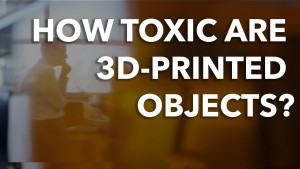Parts produced by some commercial 3D printers may be toxic according to a new study that raises concerns about how to dispose of parts and waste materials from the devices which are becoming increasingly popular. Researchers at the University of California, Riverside studied two common types of 3D printers, one that melts plastic to build a part, and another that uses light to turn a liquid into a solid part. They found that parts from both types of printers were measurably toxic to zebrafish embryos, and parts from the liquid-based printer were the most toxic. They also developed a simple post-printing treatment, exposure to ultraviolet light that reduced the toxicity of parts from the liquid-based printer.
They then decided to test the toxicity of printed objects from the two types of 3D printers. Researchers used two commercial 3D printers in their study, a Dimension Elite printer made by Stratasys (which uses melted plastic to build parts) and a Form 1+ stereolithography printer made by Formlabs (which uses liquid resin to make parts).She used each printer to create disc-shaped parts, about an inch in diameter. Then she placed the discs in petri dishes with zebrafish embryos and studied survival rates and hatch rates and monitored for developmental abnormalities. While the embryos exposed to parts from the plastic-melting printer had slightly decreased average survival rates compared to control embryos, the embryos exposed to parts from the liquid-resin printer had significantly decreased survival rates, with more than half of the embryos dead by day three and all dead by day seven. And of the few zebrafish embryos that hatched after exposure to parts from the liquid-resin printer, 100 per cent of the hatchlings had developmental abnormalities.
“These 3D printers are like tiny factories in a box. We regulate factories. We would never bring one into our home. Yet, we are starting to bring these 3D printers into our homes like they are toasters. Many people, including myself, are excited about 3D printing, but, we really need to take a step back and ask how safe these materials are,” explained Grover. Grover, Oskui discovered that parts made by both types of 3D printers were in some way toxic to the zebrafish embryos, and the parts printed by the SLR 3D printer were considerably more toxic than the FDM parts.
The research team plans to expand their study to try and narrow down exactly what substances makes the materials toxic, and also to determine at what levels they would be toxic to humans. Oskui has developed a post-printing treatment that will reduce the toxicity of parts printed with the SLR 3D printer involving exposure to ultraviolet light. For now the researchers suggest that the safest way to dispose of any 3D printed parts or waste material is to send them to a hazardous waste center.
For more information please visit: www.ucr.edu

